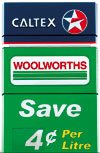Thursday, March 23, 2006
Supermarket - Petrol and Loyalty Schemes
From Choice Magazine
Supermarket sales tactics
(Shop at locally owned SmeB businesses and save up to $1.00 off per litre)
Petrol and loyalty schemes
Petrol deals
Back in 1996, WOOLWORTHS was the first supermarket to announce plans to sell petrol, and also the first with a discount offer of four cents per litre for spending $30 or more at any of its stores.The success of its move into petrol is evidenced by its 11% share of national petrol sales, according to its 2003 annual report.
The move into selling petrol isn’t just a diversification into another product: think ‘one-stop’ shopping again. One retail industry expert said supermarkets see the move as an opportunity to increase ‘share of stomach’ sales by improving the “poor retail offer by traditional petrol retailers”. COLES told us that petrol and grocery retailing “are now converging”.
What they mean is that when you stop to fill up at their petrol stations, both COLES and WOOLWORTHS hope you’ll also make a few quick grocery ‘splurchases’ at the convenience store there. There’s a trap, of course: grocery items tend to cost more at these shops than in a normal supermarket.
But how much are you really saving with the petrol discounts anyway? In August last year, Money Magazine looked into petrol offers and reported that the average motorist uses 32 L of petrol a week (based on Australian Bureau of Statistics data).
The magazine calculated that the average motorist would save $1.30 per week with the discounts — an amount that could easily disappear on one impulse buy.
Make sure the petrol offer works in your favour:
Get a feel for prices at supermarket petrol outlets, try to resist impulse buys there
Don’t drive out of your way to collect the 4 ¢/L discount.
When we asked subscribers about fuel discounts, 90% said they wouldn’t drive more than 5 km to collect a 5 ¢/L discount — a wise approach, given that the extra fuel used would eat into the saving.
Loyalty schemes
All loyalty programs are designed to encourage you to buy more in a particular store — and we must fall for them, or the companies wouldn’t spend money to run them. COLES says that cost-effective — read profitable — loyalty programs require a 1–2% investment of sale profits.
We'll be taking a close look at the value of loyalty schemes in an upcoming edition of our new magazine CHOICE Money and Rights but here’s a brief rundown of how the major supermarkets reward loyal shoppers.
COLES:
Recently revamped its ‘Fly Buys’ reward scheme: you now get two points for every $5 spent.
Also introduced ‘The Source’ COLES MYER MasterCard, which attracts Fly Buys points too (one point per $1 spent). So if you pay for your COLES MYER eligible purchases with The Source card and flash your Fly Buys card, you get seven points for every $5 spent.
Rewards start from 10,000 points, and to earn a $100 COLES MYER voucher you need 13,000 points, for which you need to spend approximately $9000. That’s a lot of spending at COLES or associated shops.
WOOLWORTHS:
Called ‘Ezy Rewards’, the program allows shoppers to accrue rewards points when using WOOLWORTHS Ezy Banking products (Commonwealth Bank-operated savings or credit accounts).
Customers get at least one point for every $1 spent and need 3600 to earn a $25 rewards voucher — an even more expensive way to get ‘free’ goods.
Subscribe to Comments [Atom]


